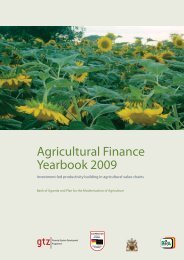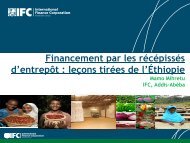<strong>Innovations</strong> <strong>in</strong> <strong>Rural</strong> <strong>and</strong> <strong>Agriculture</strong> F<strong>in</strong>anceNew Approaches for Index Insurance: ENSO Insurance <strong>in</strong> PeruJerry R. Skees <strong>and</strong> Benjam<strong>in</strong> CollierFor Food, <strong>Agriculture</strong>,<strong>and</strong> the EnvironmentThe El Niño Southern Oscillation (ENSO) is a climate eventassociated with warm<strong>in</strong>g sea surface temperatures <strong>in</strong> thePacific Ocean. In years of extreme El Niño events, areas <strong>in</strong> northernPeru experience catastrophic flood<strong>in</strong>g. As of 2010, it is possiblefor stakeholders <strong>in</strong> northern Peru to purchase a new form of<strong>in</strong>surance that pays out just as flood<strong>in</strong>g beg<strong>in</strong>s <strong>and</strong> stakeholdersbeg<strong>in</strong> <strong>in</strong>curr<strong>in</strong>g extra costs <strong>and</strong> consequential losses. Given the highbasis risk associated with sell<strong>in</strong>g <strong>in</strong>dex <strong>in</strong>surance to households,this <strong>in</strong>surance is designed for firms <strong>and</strong> <strong>in</strong>stitutions that servehouseholds that are highly exposed to El Niño. ENSO <strong>in</strong>suranceis sold by a Peruvian <strong>in</strong>surance company, <strong>and</strong> a major globalre<strong>in</strong>surer carries most of the risk. This new <strong>in</strong>surance product isthe first <strong>in</strong>surance to use sea surface temperature as the proxyfor catastrophic losses <strong>and</strong> also the first regulated “forecast <strong>in</strong>dex<strong>in</strong>surance” product <strong>in</strong> the world. This <strong>in</strong>novation could enhanceprogress <strong>in</strong> develop<strong>in</strong>g <strong>in</strong>dex-based <strong>in</strong>surance products for extremeweather events.Recent years have seen a grow<strong>in</strong>g number of pilot testsof <strong>in</strong>dex <strong>in</strong>surance for weather risk, motivated by an <strong>in</strong>creasedunderst<strong>and</strong><strong>in</strong>g of how natural disasters affect develop<strong>in</strong>g countries.Beyond immediate suffer<strong>in</strong>g (<strong>in</strong>clud<strong>in</strong>g deaths, destroyed assets, <strong>and</strong>lost <strong>in</strong>come), disasters have troublesome <strong>in</strong>direct effects: economicgrowth can be disrupted, the poor are thrust <strong>in</strong>to permanentpoverty traps, <strong>and</strong> the mere presence of these risks constra<strong>in</strong>s accessto f<strong>in</strong>ancial services <strong>and</strong> causes many decisionmakers to pursue lowreturn,low-risk strategies that impede economic progress.Much of the development of <strong>in</strong>dex <strong>in</strong>surance focuses onagriculture, because activities associated with agriculture rema<strong>in</strong>the primary livelihood strategies for the rural poor <strong>in</strong> develop<strong>in</strong>gcountries. Thus far, most <strong>in</strong>dex <strong>in</strong>surance pilots have <strong>in</strong>volvedproducts targeted at households—that is, micro-level products.Index <strong>in</strong>surance uses an objective measure (an <strong>in</strong>dex) of a naturalevent known to cause losses (such as excess ra<strong>in</strong>, high river levels, orextreme sea surface temperatures). Us<strong>in</strong>g an <strong>in</strong>dex as the proxy forloss dispenses with expensive loss assessments. Furthermore, use ofan <strong>in</strong>dex dim<strong>in</strong>ishes moral hazard <strong>and</strong> adverse selection, problemsthat plague traditional forms of <strong>in</strong>surance. Given these advantages,<strong>in</strong>dex <strong>in</strong>surance may be well suited to develop<strong>in</strong>g countries wheredata are sparse <strong>and</strong> delivery of f<strong>in</strong>ancial services to smallholderhouseholds <strong>in</strong>creases the per-unit cost of traditional <strong>in</strong>surance.Despite the promise of <strong>in</strong>dex <strong>in</strong>surance, uptake by smallholderhouseholds is slow. Presently, <strong>in</strong>dex <strong>in</strong>surance may be bettersuited for risk aggregators—that is, groups or <strong>in</strong>stitutions thataggregate the risk of households either through the servicesthey provide or through <strong>in</strong>formal risk-shar<strong>in</strong>g arrangements (forexample, agricultural lenders, firms <strong>in</strong> the value cha<strong>in</strong>, <strong>and</strong> farmerassociations). Focus<strong>in</strong>g first on risk aggregators should also helpbuild l<strong>in</strong>kages <strong>and</strong> susta<strong>in</strong>able products that will directly servesmallholder households.Index <strong>in</strong>surance <strong>and</strong> correlated lossesAs a precondition of <strong>in</strong>dex <strong>in</strong>surance, losses created by the naturaldisaster to be <strong>in</strong>sured must be strongly correlated—that is, a largeFocus 18 • Brief 11 • July 2010number of <strong>in</strong>dividuals must suffer losses at the same time. Giventhat many <strong>in</strong>dividuals suffer a loss at the same time, risk aggregatorswill also suffer serious losses. Thus, correlated losses from naturaldisasters constra<strong>in</strong> the development of credit markets for the ruralpoor, particularly for those <strong>in</strong>volved <strong>in</strong> agriculture. Lenders cannotabsorb the risk exposure of a large number of borrowers who may beunable to pay off loans after a major natural disaster.Likewise, an <strong>in</strong>surer decid<strong>in</strong>g to write any form of <strong>in</strong>suranceaga<strong>in</strong>st extreme weather events must have a means to transfer theserisks—generally through a global re<strong>in</strong>surer. Insurers <strong>in</strong> develop<strong>in</strong>gcountries often f<strong>in</strong>d obta<strong>in</strong><strong>in</strong>g access to re<strong>in</strong>surance marketsdifficult. If the <strong>in</strong>dex be<strong>in</strong>g used is fully transparent, the globalre<strong>in</strong>surer is more likely to feel comfortable with the systems used toestimate the <strong>in</strong>dex. This is certa<strong>in</strong>ly the case for ENSO measurements,which have been developed over more than 50 years by the U.S.National Oceanic <strong>and</strong> Atmospheric Adm<strong>in</strong>istration (NOAA).Extreme weather events such as drought <strong>and</strong> flood<strong>in</strong>g can alsohave associated consequential losses that extend beyond traditionalcrop <strong>in</strong>surance, which pays for losses of a specific crop. For example,<strong>in</strong> a number of African countries, where own<strong>in</strong>g livestock is a formof sav<strong>in</strong>gs, extreme droughts compel large numbers of farmers tosell their livestock at the same time. Distressed sales of livestockon local markets depress local prices, compound<strong>in</strong>g losses. Floods<strong>and</strong> droughts also generally <strong>in</strong>fluence the quality of crops, not justyields. Moreover, risk-management strategies to diversify cropp<strong>in</strong>genterprises can quickly prove <strong>in</strong>effective if droughts or floodsnegatively affect all of the crops at the same time.ENSO <strong>in</strong>surance as a form of bus<strong>in</strong>ess<strong>in</strong>terruption<strong>in</strong>suranceIn Peru, where ENSO <strong>in</strong>surance is be<strong>in</strong>g tested, the consequentiallosses <strong>and</strong> problems associated with extreme ra<strong>in</strong>fall <strong>and</strong>catastrophic flood<strong>in</strong>g are enormous—crops are lost, trees die, soilswash away, transportation systems break down, <strong>in</strong>cidence of disease(such as malaria) <strong>in</strong>creases, <strong>and</strong> markets are destroyed. When<strong>in</strong>dividuals <strong>and</strong> local markets suffer <strong>in</strong> this fashion, firms <strong>in</strong> thevalue cha<strong>in</strong> <strong>and</strong> the f<strong>in</strong>ancial sector also suffer.In the extreme El Niño years 1983 <strong>and</strong> 1998, the volume ofwater <strong>in</strong> the Piura River was about 40 times greater than normal.Although Piura was among the worst-affected areas, a number ofother regions <strong>in</strong> northern Peru were also severely affected. In 1998,with a clear <strong>in</strong>dication that El Niño was com<strong>in</strong>g, farmers simply didnot plant crops, result<strong>in</strong>g <strong>in</strong> a 27 percent drop <strong>in</strong> fertilizer sales <strong>in</strong>northern Peru. Agricultural lend<strong>in</strong>g was grow<strong>in</strong>g at a significantpace before the 1997–98 El Niño, but that growth came to a haltafter the event. Microf<strong>in</strong>ance <strong>in</strong>stitutions (MFIs) had a significant<strong>in</strong>crease <strong>in</strong> problem loans. Because of the 1998 El Niño, the defaultrate on agricultural loans <strong>in</strong>creased from about 8 percent of allagricultural loans to more than 18 percent for MFIs operat<strong>in</strong>g <strong>in</strong> theregion of Piura. Loan default is def<strong>in</strong>ed as loans that were 60 dayslate or more <strong>in</strong> payments. Once loans fall <strong>in</strong>to this category, theprobability of collection is nearly zero. Additionally, member deposits<strong>and</strong> sav<strong>in</strong>gs—the major sources of capital for the MFIs— decl<strong>in</strong>ed
y roughly 15 percent as people withdrew funds to cope with theproblems created by the event. It took at least three years to recoverfrom the compounded problems of loan defaults, loan restructur<strong>in</strong>g,<strong>and</strong> sav<strong>in</strong>gs <strong>and</strong> member deposit withdrawals.ENSO <strong>in</strong>surance was presented to the Peruvian <strong>in</strong>suranceregulators as a form of bus<strong>in</strong>ess-<strong>in</strong>terruption <strong>in</strong>surance designedto pay for consequential losses <strong>and</strong> extra costs l<strong>in</strong>ked to extremeflood<strong>in</strong>g, which is highly correlated with ENSO. ENSO <strong>in</strong>surancefits well <strong>in</strong> a class of <strong>in</strong>surance called “cont<strong>in</strong>gency <strong>in</strong>surance.”Cont<strong>in</strong>gency <strong>in</strong>surance is <strong>in</strong>tended to protect policyholders aga<strong>in</strong>sta variety of consequences associated with a specific event; theseconsequences can <strong>in</strong>clude loss of assets, losses <strong>in</strong> normal bus<strong>in</strong>essrevenues, <strong>and</strong> <strong>in</strong>creased costs associated with address<strong>in</strong>g the event.Experience <strong>in</strong> Peru suggests that formulat<strong>in</strong>g <strong>in</strong>dex <strong>in</strong>surance ascont<strong>in</strong>gency <strong>in</strong>surance aga<strong>in</strong>st a natural disaster has potentialapplications <strong>in</strong> many regions of the world highly exposed to severeweather risks such as drought or flood.The ENSO <strong>in</strong>surance uses the monthly sea surface temperaturefor ENSO Region 1.2 (0–10° South, 80–90° West), measured <strong>and</strong>reported by the NOAA Climate Prediction Center. The basis forpayment is the average of two months—November <strong>and</strong> December.Three contracts are available with three different thresholds wherepayments beg<strong>in</strong> (23.4, 24.0, <strong>and</strong> 24.5 degrees Celsius); each ofthese contracts reaches a maximum when the measure reaches27 degrees. The payout function is l<strong>in</strong>ear. Indemnity paymentsare made <strong>in</strong> early January, just as flood<strong>in</strong>g beg<strong>in</strong>s, <strong>and</strong> flood<strong>in</strong>gcont<strong>in</strong>ues from February to April.Indemnity payments are made by multiply<strong>in</strong>g the payout ratetimes the sum <strong>in</strong>sured, which is selected by the <strong>in</strong>sured party. A riskassessment that estimates the largest losses that may occur underthe worst flood<strong>in</strong>g event is likely the best start<strong>in</strong>g po<strong>in</strong>t for select<strong>in</strong>ga sum to be <strong>in</strong>sured. Prudent buyers of <strong>in</strong>surance will be morelikely to select a value that is less than these estimates, given theexpense of this type of <strong>in</strong>surance <strong>and</strong> the fact that they have otherrisk-management mechanisms that can be blended with the ENSO<strong>in</strong>surance <strong>in</strong> an optimal fashion.S<strong>in</strong>ce the ENSO <strong>in</strong>surance pays before the catastrophe,educational efforts have focused on help<strong>in</strong>g people <strong>in</strong> the targetmarkets underst<strong>and</strong> how to use the extra cash to mitigate theimpend<strong>in</strong>g crisis. Farmers’ associations <strong>in</strong> remote regions of Piura haveexpressed an <strong>in</strong>terest <strong>in</strong> us<strong>in</strong>g the funds to clear dra<strong>in</strong>age systemsbecause heavy ra<strong>in</strong>s associated with ENSO <strong>in</strong>crease the likelihood thatdra<strong>in</strong>age systems will clog. Lenders are <strong>in</strong>terested <strong>in</strong> us<strong>in</strong>g paymentsto ease the liquidity crisis <strong>and</strong> associated cost. Those <strong>in</strong> the valuecha<strong>in</strong> are <strong>in</strong>terested <strong>in</strong> smooth<strong>in</strong>g their losses <strong>and</strong> ma<strong>in</strong>ta<strong>in</strong><strong>in</strong>g theirspecialized workforce when revenues are temporarily low becauseof El Niño. F<strong>in</strong>ally, ENSO <strong>in</strong>surance is also be<strong>in</strong>g offered to local<strong>and</strong> regional governments to provide ready cash to mitigate someproblems associated with catastrophic flood<strong>in</strong>g.To beg<strong>in</strong>, the <strong>in</strong>surance company is offer<strong>in</strong>g ENSO <strong>in</strong>suranceonly to highly exposed risk aggregators. Dem<strong>and</strong> from other firms<strong>and</strong> <strong>in</strong>stitutions that are exposed to El Niño risk will then drive theexpansion of this market. Anecdotal evidence po<strong>in</strong>ts to substantial<strong>in</strong>terest <strong>in</strong> ENSO <strong>in</strong>surance. After some <strong>in</strong>itial press releases on theproduct, the <strong>in</strong>surer was <strong>in</strong>undated with calls from a variety offirms <strong>and</strong> <strong>in</strong>stitutions <strong>in</strong>terested <strong>in</strong> the product. At this stage, ENSO<strong>in</strong>surance is not be<strong>in</strong>g made available to smallholder households.The product can, however, be tied to other f<strong>in</strong>ancial services <strong>in</strong> afashion that gives smallholders greater access to these services atbetter prices.ConclusionEl Niño events affect many regions of the world. The most dramaticeffects probably occur <strong>in</strong> Peru <strong>and</strong> Ecuador, but El Niño affectsother countries <strong>in</strong> South, Central, <strong>and</strong> North America as wellas <strong>in</strong> Southeast Asia <strong>and</strong> East Africa. In some regions, El Niñois associated with flood<strong>in</strong>g, <strong>and</strong> <strong>in</strong> others it is associated withdrought. Although no other region may have as strong a correlationbetween sea surface temperature <strong>and</strong> flood<strong>in</strong>g as northern Peru <strong>and</strong>southern Ecuador, this project may <strong>in</strong>crease awareness <strong>and</strong> lead tonew th<strong>in</strong>k<strong>in</strong>g <strong>and</strong> opportunities regard<strong>in</strong>g the potential for forecast<strong>in</strong>dex <strong>in</strong>surance <strong>and</strong> the relationship between natural disaster risk<strong>and</strong> oceanic oscillations such as ENSO. nFor further read<strong>in</strong>g: J. R. Skees, J. Hartell, <strong>and</strong> A. Murphy,“Us<strong>in</strong>g Index-based Risk Transfer Products to FacilitateMicro Lend<strong>in</strong>g <strong>in</strong> Peru <strong>and</strong> Vietnam,” American Journal ofAgricultural Economics 89 (2007): 1255–61; J. R. Skees, “Challengesfor Use of Index-based Weather Insurance <strong>in</strong> Lower-Income Countries,” Agricultural F<strong>in</strong>ance Review 68 (Spr<strong>in</strong>g2008): 197–217; J. R. Skees <strong>and</strong> B. J. Barnett, “Enhanc<strong>in</strong>gMicro F<strong>in</strong>ance Us<strong>in</strong>g Index-based Risk Transfer Products,”Agricultural F<strong>in</strong>ance Review 66 (2006): 235–50.Jerry R. Skees (jskees@uky.edu) is president of GlobalAgRisk <strong>and</strong> the H. B. Price professor of policy <strong>and</strong> risk <strong>in</strong> the Department of Agricultural Economicsat the University of Kentucky. Benjam<strong>in</strong> Collier (benjam<strong>in</strong>@globalagrisk.com) is an employee of GlobalAgRisk <strong>and</strong> a PhD c<strong>and</strong>idate <strong>in</strong> the Department ofAgricultural Economics at the University of Kentucky.International Food PolicyResearch InstituteSupported susta<strong>in</strong>able solutions by the for CGIAR end<strong>in</strong>g hunger <strong>and</strong> povertywww.ifpri.orgSupported by the CGIARwww.worldbank.orgCopyright © 2010 International Food Policy Research Institute <strong>and</strong> the World Bank. All rights reserved. Contact ifpri-copyright@cgiar.org or pubrights@worldbank.org for permission to republish.







